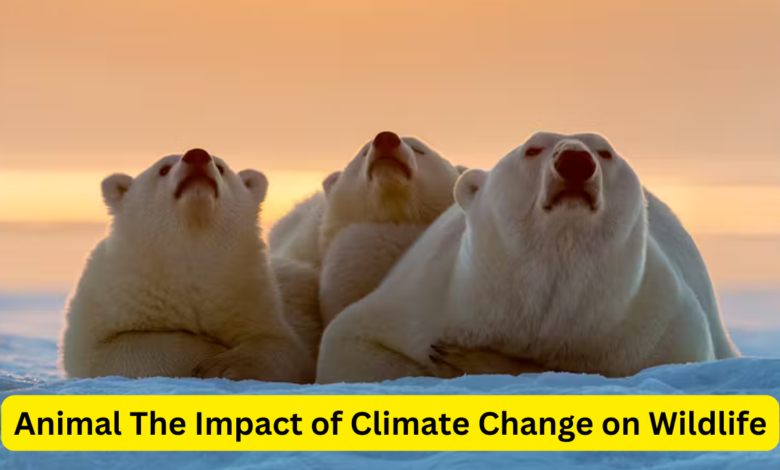Animal

Animal The Impact of Climate Change on Wildlife, Climate change is an ever-present force reshaping our world, with particularly devastating impacts on wildlife. As global temperatures rise and ecosystems undergo rapid alterations, many species face unprecedented challenges that threaten their survival. The urgency of addressing climate change cannot be overstated, especially when it comes to protecting the biodiversity that forms the backbone of our planet’s ecological balance. This article delves into the multifaceted ways in which climate change affects wildlife, focusing on the most vulnerable species and habitats.
Understanding Climate Change and Its Effects on Ecosystems
Climate change, driven by a combination of natural processes and human activities such as the burning of fossil fuels, deforestation, and industrial pollution, leads to an increase in global temperatures. This warming effect is coupled with more frequent extreme weather events and shifts in seasonal patterns. These changes profoundly impact ecosystems, disrupting the delicate balance that countless species rely on for survival.
Rising Temperatures and Habitat Loss
One of the most significant and immediate impacts of climate change is the rise in global temperatures. Many species are adapted to thrive within specific temperature ranges, and even slight increases can disrupt their ability to survive. For example, polar bears in the Arctic are heavily dependent on sea ice for hunting seals, their primary food source. As climate change causes ice to melt earlier in the year and form later, polar bears have less time to hunt, leading to food scarcity and increased mortality rates.
Similarly, coral reefs, which are vital to about 25% of marine life, are extremely sensitive to temperature fluctuations. When water temperatures rise, corals undergo a process known as bleaching, where they expel the symbiotic algae that provide them with color and energy. This not only causes the corals to die but also triggers the collapse of entire reef ecosystems, resulting in a significant loss of biodiversity.
Changing Precipitation Patterns and Water Availability
The alteration of precipitation patterns is another profound consequence of climate change, impacting wildlife across the globe. In some regions, increased rainfall leads to flooding, which destroys habitats and displaces species. Conversely, other areas experience prolonged droughts that drastically reduce water availability, affecting both plant and animal life.
In Africa, for instance, shifting rainfall patterns have led to the desertification of once-lush savannas, threatening iconic species such as elephants, lions, and zebras. As water sources dry up, these animals are forced to travel greater distances to find water, often bringing them into conflict with human populations as they encroach on agricultural lands.
Impact on Migration Patterns
Many species rely on precise timing for migration, breeding, and feeding cycles. Climate change disrupts these patterns, leading to mismatches that can have severe repercussions. For example, birds may arrive at their breeding grounds to find that the insects they depend on for nourishment have already peaked due to an earlier onset of spring. This mismatch can result in lower reproductive success and declining bird populations.
Moreover, the timing of plant blooming is being altered, with some species flowering earlier in the year in response to warmer temperatures. This shift can disrupt the life cycles of pollinators such as bees and butterflies, which in turn impacts the entire food chain and can lead to broader ecological imbalances.
Ocean Acidification and Its Impact on Marine Life
In addition to rising temperatures, the world’s oceans are absorbing significant amounts of carbon dioxide (CO2), leading to a process known as ocean acidification. This chemical shift decreases the pH of seawater, posing a threat to marine life, particularly species that rely on calcium carbonate to build their shells and skeletons, such as mollusks, crabs, and corals.
Ocean acidification also has broader implications for marine ecosystems. For instance, acidified waters can impair the sense of smell in fish, making it more difficult for them to detect predators or find food. This disruption can have cascading effects, ultimately impacting human communities that rely on marine species for sustenance and economic stability.
Increased Frequency of Extreme Weather Events
Climate change is driving an increase in the frequency and severity of extreme weather events, including hurricanes, wildfires, and floods. These events can have immediate and devastating impacts on wildlife, destroying habitats, reducing food availability, and causing direct harm to animals.
The wildfires that have devastated parts of Australia and the Amazon rainforest in recent years serve as stark examples of this phenomenon. The loss of vast areas of habitat and the death of millions of animals highlight the profound and often irreversible damage caused by such events. Recovery is slow, and many species may never fully recover, leading to long-term declines in biodiversity.
The Role of Conservation Efforts
Despite the challenges, conservation efforts offer hope for mitigating the impact of climate change on wildlife. Organizations around the world are working tirelessly to protect critical habitats, restore ecosystems, and develop strategies to help species adapt to changing conditions.
One effective approach is the creation of wildlife corridors, which connect fragmented habitats and allow species to move in response to environmental changes. This is especially important for species that need to migrate to cooler areas as global temperatures rise. Additionally, restoration projects, such as reforestation initiatives, can help sequester carbon and provide essential habitats for wildlife, bolstering their chances of survival.
The Importance of Global Action
Addressing the impact of climate change on wildlife requires a coordinated global effort. Reducing greenhouse gas emissions, protecting and restoring ecosystems, and supporting conservation initiatives are all critical components of a comprehensive strategy. Moreover, raising awareness about the importance of wildlife conservation in the context of climate change is essential for garnering public and political support.
Conclusion
The effects of climate change on wildlife are profound and multifaceted, posing one of the greatest challenges to biodiversity conservation in our time. As temperatures continue to rise and weather patterns shift, the need for effective conservation strategies and global cooperation becomes ever more urgent. Protecting the planet’s wildlife is not only about preserving the beauty and diversity of nature but also about ensuring the health and stability of the ecosystems that support life on Earth.





2 Comments